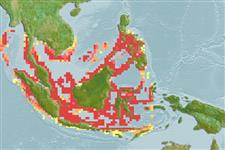Common names from other countries
>
Syngnathiformes (Pipefishes and seahorses) >
Syngnathidae (Pipefishes and seahorses) > Syngnathinae
Etymology: Hippocampus: Greek, ippos = horse + Greek,kampe = curvature (Ref. 45335).
Environment: milieu / climate zone / depth range / distribution range
Ecologia
marinhas associadas(os) a recifes; não migratória; intervalo de profundidade 0 - 32 m (Ref. 128812). Tropical; 15°N - 10°S, 91°E - 128°E
Indo-West Pacific: India (Andaman Islands), Indonesia, Malaysia, Philippines, Singapore, Thailand, Viet Nam. Confused with Hippocampus kuda.
Length at first maturity / Tamanho / Peso / Idade
Maturity: Lm 8.1 range ? - ? cm
Max length : 18.7 cm OT macho/indeterminado; (Ref. 52034)
Descrição breve
Chaves de identificação | Morfologia | Morfometria
Espinhos dorsais (total) : 0; Raios dorsais moles (total) : 17 - 19.
Length type refers to Height (= from top of coronet to the tip of straightened tail). This species is mainly found in pairs (Ref. 48635) on coral reefs, sponge gardens, kelp, and floating Sargassum. Nocturnal, site faithful. Feeds on zooplankton (Ref. 85309). Ovoviviparous (Ref. 205). The male carries the eggs in a brood pouch which is found under the tail (Ref. 205). Life span probably more than 2-3 years. Used for traditional Chinese medicine (Ref. 85309).
Monogamous mating is observed as both obligate and genetic (Ref. 52884). Male carries the eggs in a brood pouch (Ref. 205). Gestation period 2-3 weeks (but varies with water temperature) (Ref. 30915).
Lourie, S.A., R.A. Pollom and S.J. Foster, 2016. A global revision of the seahorses Hippocampus Rafinesque 1810 (Actinopterygii: Syngnathiformes): taxonomy and biogeography with recommendations for further research. Zootaxa 4146(1):1-66. (Ref. 115213)
Categoria na Lista Vermelha da IUCN (Ref. 130435)
Ameaça para o homem
Harmless
Utilização humana
Pescarias: espécies comerciais; Aquário: Espécies comerciais
Ferramentas
Relatórios especiais
Descarregue XML
Fontes da internet
Estimates based on models
Preferred temperature (Ref.
115969): 28.3 - 29.3, mean 28.8 (based on 688 cells).
Phylogenetic diversity index (Ref.
82804): PD
50 = 0.5000 [Uniqueness, from 0.5 = low to 2.0 = high].
Bayesian length-weight: a=0.00447 (0.00177 - 0.01127), b=3.00 (2.78 - 3.22), in cm Total Length, based on LWR estimates for this (Sub)family-body shape (Ref.
93245).
Nível Trófico (Ref.
69278): 3.4 ±0.5 se; based on size and trophs of closest relatives
Resiliência (Ref.
120179): Elevada, tempo mínimo de duplicação da população menor que 15 meses (tm=0.5-1).
Fishing Vulnerability (Ref.
59153): Low vulnerability (10 of 100).
